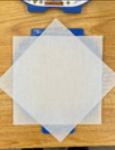When you’re looking for scrubs, you don’t have to go far to find the WonderWink® brand and to learn why it is so popular. It provides the functionality, silhouettes and modern fabrics that medical professionals need. In the promotional industry, the kicker is that we are tasked with decorating these stretchable, lightweight and functional garments.
Typically, end users choose embroidery when decorating on scrubs. However, other techniques, like heat transfer, are also great alternatives when looking at options. Our task is to decide the best decoration technique and figure out the nuances required to decorate the garment while considering the fabric’s content.
Whether you choose to embroider or use heat transfers, there are some elements you should consider to make sure your end result goes above and beyond what your customer requests. Before we get too far, let’s get familiar with the fabric content of the two WonderWink® product lines:
- WorkFlexTM: 65/35 Poly/Cotton with Mechanical Stretch
- Premiere FlexTM: 78/20/2 Poly/Rayon/Spandex
EMBROIDERY
 Embroidery is the most common method when decorating scrubs for logos and personalization. As fabrics continue to evolve, they may require additional processes or equipment to achieve the best results.
Embroidery is the most common method when decorating scrubs for logos and personalization. As fabrics continue to evolve, they may require additional processes or equipment to achieve the best results.
Below are a few tricks to consider as you navigate different production values that you’ll face. It is always recommended to reach out to your supplier to verify each material is best suited for the garment.
- Digitizing and Density
- Center run underlay
- Maintain densities around a .4 setting
- Too many stitches in a logo could result in puckering and even needle cut
- Needles
- 65/9 light ball point or 75/11 sharp
- Thread
- Be sure to use polyester thread
- Backing
- Performance woven stabilizer, double layer, offset by 45 degrees
- The offset will assist in stabilizing fabrics with stretch
- Hooping
- Be careful not to set your tension too high as there is a risk of the fabric being over stretched during decoration, creating an environment for puckering when released.
HEAT TRANSFER
A primary benefit for using heat transfers on scrubs is that you may be able to place embellishments over seams, pockets and other areas that are traditionally difficult to decorate.
Below are a few tricks to consider as you navigate different production values that you’ll face. With heat transfer, it is always recommended to reach out to your supplier to verify each transfer is best suited for the garment.
- Heat
Low temperature applications are preferred due to the polyester and spandex blends. - Accessories
Use of craft paper may be preferred over Teflon. - Transfer
Many suppliers offer a stretch material that may work best for this application. With polyester blends, you may also need a dye blocker.
Whether you’re applying a corporate logo, personalizing years of experience and title or creating someone’s McDreamy Halloween costume, we hope that these callouts assist in the success of your projects. The good news is, with a bit of practice and possibly a few small investments in accessories, you can find success and gain new business opportunities!
For additional tips around general lightweight fabrics, check our video about embroidering lightweight knits. If you have any questions, please consult your equipment supplier or you can always reach out to our Decorator and Digital Solutions Team at decoratorrelations@sanmar.com.
